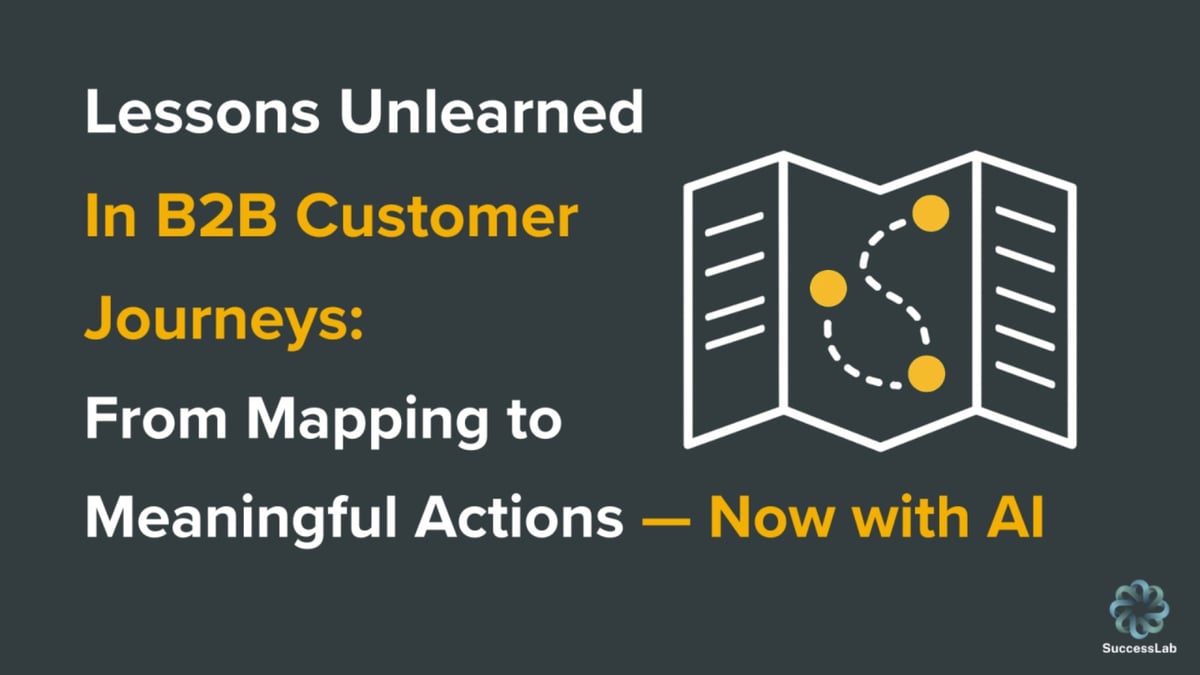Lessons Unlearned in B2B Customer Journeys: From Mapping to Meaningful Action—Now with AI

Omid Razavi
April 13, 2025
"Pretty maps, broken journeys."
After 25+ years in enterprise technology, including 15 years deeply immersed in SaaS Customer Success, Support, and Services, I've seen this movie more than a few times.
It always starts the same way: A leadership team nodding enthusiastically at the idea of customer journey mapping.
The high point? A beautifully designed visual in a slide deck.
The conclusion? More often than not, very little changes.
But now—with the rise of AI—we have a chance to break that cycle.
AI enables us to move beyond static documentation into dynamic systems of action.
With predictive insights, we can anticipate risk and intervene early.
With generative AI, we can scale personalized experiences without scaling headcount.
With journey intelligence, we can finally connect cross-functional efforts to measurable customer outcomes.
What Is Customer Journey Mapping—Really?
Customer Journey Mapping is the structured process of visualizing how a customer experiences your company—from first touch to renewal and expansion. Done right, it's more than a diagram. It's a diagnostic tool, an alignment framework, and a strategic blueprint for value delivery.
It captures:
- The key stages in the customer lifecycle
- The touchpoints—both human and digital—that shape perception
- The pain points that erode trust and the moments that matter
- The internal handoffs and system breakdowns that customers never forget
Increasingly, journey mapping is enhanced by AI-powered insights that help organizations identify patterns, predict risks, and personalize engagement at scale. AI can surface friction points in real time, recommend interventions, and automate routine tasks, allowing teams to focus on high-impact moments.
In short, journey mapping answers one question:
What is it like to be your customer, and what are you doing to improve that systematically and intelligently?
Why It Matters (Even More in B2B)
In B2C, a poor experience often means one lost sale. In B2B, it's an entire relationship at risk—sometimes a multi-year, multi-million-dollar one.
In complex enterprise ecosystems, the customer journey spans multiple roles, teams, technologies, and expectations. Every disjointed handoff, unmet promise, or clunky onboarding moment compounds risk.
Customer Journey Mapping becomes essential not as a feel-good exercise but as an operating model for driving retention, expansion, and advocacy. With the help of AI, these efforts can now become more dynamic, data-driven, and proactive.
So Why Do So Many Organizations Get It Wrong?
Because they mistake the output for the outcome.
They build a static map, assign no owners, track no metrics, and make no changes.
They treat it as a CS initiative, not a cross-functional strategy.
They build it from the inside out—based on what they do—not what the customer experiences. They map it once and forget it forever.
Most of all, they assume agreement on the "why" when, in fact, everyone is solving for different things.
These are the lessons unlearned. And they're why most B2B journey mapping efforts fail to create meaningful action.
1. Start With Shared Goals: Define the Strategic Intent
Before designing journeys, design intent. What are you optimizing for? Unless the organization agrees on what the journey map is intended to solve, the effort will fragment into departmental priorities.
In mature organizations, the journey map is not an experience design exercise—it's a strategic operating model for delivering customer outcomes.
A journey map is a strategic operating model for delivering customer outcomes.
Examples of high-leverage goals:
- Reduce churn and improve renewal and expansion outcomes
- Accelerate onboarding and reduce time-to-value
- Improve product adoption and long-term stickiness
- Surface friction in internal handoffs and customer-facing touchpoints
- Enable better interlock between Sales, Success, Product, and Support
- Personalize experiences by tier, role, or intent
- Inform roadmap priorities based on customer impact, not internal bias
Pro Tip: Treat goal-setting as the first deliverable. Don't start mapping until you've achieved cross-functional alignment on what success looks like—and what questions the journey map is intended to answer.
2. Map the Entire Lifecycle—Not Just Pre-Sale or Post-Sale
One of the most persistent pitfalls in B2B journey mapping is treating the customer lifecycle as a segmented process. Sales and Marketing focus on acquisition. Customer Experience and Success focus on onboarding and usage. No one owns the whole experience.
That's a design failure.
The customer experiences one continuous journey. Whether your org is aligned or not is irrelevant to them. They judge the business on outcomes, not org charts.
A complete customer journey should cover:
Awareness → Evaluation → Purchase → Onboarding → Adoption → Value Realization → Renewal → Expansion
It should also account for:
- Key handoff points (e.g., Sales to CS)
- Common breakdowns in continuity (e.g., promises made in the sales cycle that post-sales can't deliver)
- In-product and human touchpoints mapped to moments that matter

Archetypal SaaS Customer Journey
Pro Tip: If your journey map ends with a contract—or starts after one is signed—you're not mapping a journey. You're documenting a department. Start from the customer's perspective and work across the lifecycle.
3. Use a Multi-Persona, Multi-Layer Approach
In B2B, there is no singular "customer." There are buyers, users, influencers, and blockers—each with distinct goals, pain points, and definitions of value. A one-size-fits-all map guarantees blind spots.
Any journey map that collapses multiple personas into a single path will fail to drive actionable change.
Pro Tips:
- Develop persona-specific maps that reflect how each role experiences the journey.
- Include each persona's goal states, emotional context, pain points, and success criteria.
- Build a unified view by layering front-stage (customer experience) with back-stage (internal processes), exposing handoff failures, tool friction, and role ambiguity.
4. Ground the Map in Data—Both Quantitative and Qualitative
Intuition alone isn't strategy. The journey map becomes a guessing game without behavioral evidence and customer voice.
Credibility is the currency of change. If your map isn't backed by data, it won’t survive executive scrutiny.
Pro Tips:
- Pull structured data from systems like your CRM (e.g., Salesforce), Customer Success platforms (e.g., Gainsight), and product analytics tools (e.g., Mixpanel) to ground your map in measurable behavior.
- Combine this with unstructured insights—customer interviews, churn debriefs, win/loss analysis, and verbatim feedback from CSAT, NPS, and sentiment tools (e.g., SupportLogic).
- Leverage AI-enabled journey analytics to pinpoint friction, identify drop-off moments, and surface predictive patterns that manual reviews may miss.
5. Make It Actionable: Tie Every Stage to Roles, Metrics, and Outcomes
A journey map should function as an operating manual. If it doesn't define who does what, with which tools, and to what end, it's incomplete.
Accountability converts insight into impact.
Pro Tips:
- For each stage, define:
- Use the map to inform OKRs, performance management, and playbooks.
- Leverage predictive AI to flag accounts falling off track and generative AI to suggest next-best actions or personalized outreach tied to each journey stage.
- Ensure every touchpoint ties back to a measurable business outcome—not just an activity log.
6. Make It Operational: Build It Into Systems, Rituals, and Reviews
A map in a deck is a decoration. A map in your systems of engagement is a transformation.
Strategy becomes reality only when embedded in systems and rituals.
Pro Tips:
- Use journey stages as filters and views in your CRM and CS tools.
- Embed journey logic into AI-powered workflows—automate nudges, reminders, or handoffs based on real-time journey progression.
- Review journey performance during QBRs, roadmap planning, and cross-functional reviews.
- Build dashboards that track journey-specific KPIs: time-to-value, adoption velocity, support resolution rate.
7. Involve All Key Functions—Not Just CS
Customer Success may sponsor the initiative, but they can't deliver it alone.
You can't fix a cross-functional journey with a single-function solution.
Pro Tips:
- Sales: Surface misaligned expectations and fragile handoffs. Use AI to analyze deal promises and map them to delivery milestones.
- Product: Tie in-product behavior to lifecycle stages. Use telemetry data and AI to uncover adoption patterns and latent friction.
- Support: Highlight points of friction and recurring issues. Let AI categorize and cluster support tickets by journey impact.
- Marketing: Ensure messaging matches reality across the journey. Use AI to tailor lifecycle messaging by persona and intent.
8. Communicate and Activate: Make the Map Part of the Culture
If your employees can't name the journey stages, they won't deliver against them.
If it’s not lived in the culture, it won’t show up in the execution.
Pro Tips:
- Host internal roadshows and enablement to evangelize the journey.
- Bake journey fluency into new hire onboarding and manager training.
- Use journey stories in exec updates, customer conversations, and board discussions.
- Enable AI copilots to provide in-the-moment journey context during calls, QBRs, or internal reviews.
9. Drive Change With Iteration and Feedback Loops
Maps are not one-and-done. Like products, they must evolve based on use.
A journey map is a prototype—until it's validated by outcomes.
Pro Tips:
- Prioritize 2–3 critical improvements post-mapping.
- Track before-and-after metrics to assess lift.
- Review and refine maps quarterly or semi-annually.
- Solicit feedback from customer-facing teams and customers themselves.
- Use AI-generated summaries and insights from feedback and performance data to guide continuous refinement.
10. Embed Change Management Principles
The journey map changes workflows, expectations, and accountability.
Without change management, your journey map is just another initiative lost to inertia.
Pro Tips:
- Appoint champions across functions to drive adoption.
- Secure executive sponsors to model behavior and remove blockers.
- Communicate the "why" and "what's changing" consistently.
- Celebrate early wins and publish success stories to build momentum.
- Support change adoption with AI-generated training modules, nudges, and reinforcement through digital channels.
The Bottom Line: Journey Mapping Is a Discipline, Not a Deliverable
Customer Journey Mapping is not a design exercise. It is an operating model for customer-centered growth.
Done well, it creates a shared language across teams, drives alignment around value delivery, and improves retention, expansion, and product-market fit.
To deliver on that promise, B2B organizations must:
- Align on clear goals and shared success metrics
- Map the whole lifecycle, not departmental slices
- Ground insights in data, not opinions
- Assign ownership and accountability to every moment that matters
- Integrate the journey into systems, rituals, and reviews
- Commit to continuous iteration and change management
- Harness generative and predictive AI to scale, personalize, and proactively manage the journey
Journey mapping won’t solve your problems. But it will make them visible—and visibility is the first step to transformation.
If this resonated, you’re not alone. Join the conversation by subscribing to CCO Perspectives—a newsletter for leaders shaping the future of Customer Success, Strategy, and Growth.
We’d love to hear your perspective: What’s worked well in your journey mapping efforts? Where have you run into challenges? Let’s learn from each other.
Like
Comments (0)
Popular
Dive in
Related
Blog
AI in Customer Service: Key Takeaways from a Year of CSS Forums and What’s Next for 2025
Nov 2nd, 2024 • Views 0
Blog
Transforming Customer Success and Support with AI: Highlights from the CSS Executive Forum - Chicago
Nov 18th, 2024 • Views 0
Blog
Embracing AI in Customer Success, Support and Advocacy: Insights from the CSS Forum Portland
Aug 7th, 2024 • Views 1
Blog
Transforming Customer Success and Support with AI: Highlights from the CSS Executive Forum - Chicago
Nov 18th, 2024 • Views 0
Blog
Embracing AI in Customer Success, Support and Advocacy: Insights from the CSS Forum Portland
Aug 7th, 2024 • Views 1
Blog
AI in Customer Service: Key Takeaways from a Year of CSS Forums and What’s Next for 2025
Nov 2nd, 2024 • Views 0

